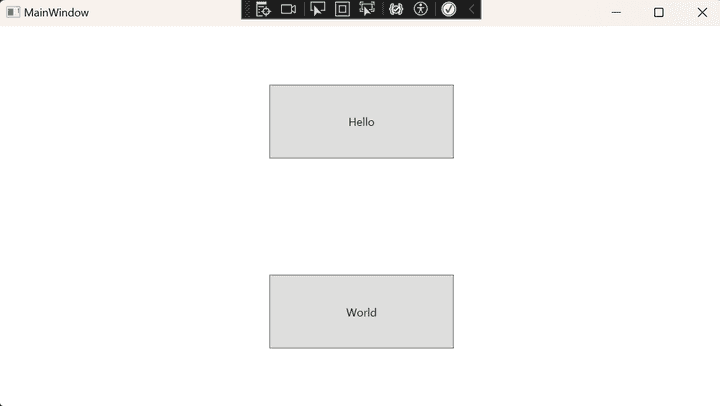💡
WPF 화면이동 구현 - Page 사용
June 10, 2024
시작은 MainWindow
MainWindow.xaml
<Window x:Class="WPF_Tutorial.MainWindow"
xmlns="http://schemas.microsoft.com/winfx/2006/xaml/presentation"
xmlns:x="http://schemas.microsoft.com/winfx/2006/xaml"
xmlns:d="http://schemas.microsoft.com/expression/blend/2008"
xmlns:mc="http://schemas.openxmlformats.org/markup-compatibility/2006"
xmlns:local="clr-namespace:WPF_Tutorial"
mc:Ignorable="d"
Title="MainWindow" Height="450" Width="800">
<Grid>
<Frame Source="/MenuPage.xaml"></Frame>
</Grid>
</Window>그리드에 Frame 태그의 Source에 MenuPage링크를 직접 넣어주면 MenuPage의 화면이 띄워짐
MenuPage.xaml (그리드부분)
<Grid>
<Grid.RowDefinitions>
<RowDefinition Height="1*"></RowDefinition>
<RowDefinition Height="1*"></RowDefinition>
</Grid.RowDefinitions>
<Grid Grid.Row="0">
<Button Width="200" Height="80" Click="Button_Click_1" Content="Hello"></Button>
</Grid>
<Grid Grid.Row="1">
<Button Width="200" Height="80" Click="Button_Click_2" Content="World"></Button>
</Grid>
</Grid>화면을 Row를 이용해 2분할하고 Hello 버튼과 World 버튼을 넣고 각각의 클릭 이벤트를 만듬
- 넓이와 넓이를 직접 지정해주면 자식 요소는 부모 요소의 크기 만큼 당겨주는 특징 때문에 가운데 정렬됨
MenuPage.cs
namespace WPF_Tutorial
{
/// <summary>
/// MenuPage.xaml에 대한 상호 작용 논리
/// </summary>
public partial class MenuPage : Page
{
public MenuPage()
{
InitializeComponent();
}
private void Button_Click_1(object sender, RoutedEventArgs e)
{
Uri uri = new Uri("/page1.xaml", UriKind.Relative);
NavigationService.Navigate(uri);
}
private void Button_Click_2(object sender, RoutedEventArgs e)
{
Uri uri = new Uri("/page2.xaml", UriKind.Relative);
NavigationService.Navigate(uri);
}
}
}각 버튼의 클릭이벤트에서 URI를 생성하고 Navigate 를 이용해 각 페이지로 이동하도록 구현함
- page1.xaml 과 page2.xaml은 Grid 안에 TextBlock을 만들어서 Hello 와 World 를 찍었음
결과

각 버튼을 누르면 가운데에 Hello 와 World 가 출력됨 WPF는 뒤로가기를 구현하지 않아도 자동으로 생성됨